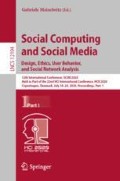Abstract
Recently, due to the expansion of TV or smart phone, the frequency of exposing media has increased. Also, the way of interacting with the media is diversifying by life stages or life balance. In such situations, people get much information about products and services on media. Therefore, it is important to select the best media for advertisement. In this study, we analyze the characteristics of exposing media using media exposure data. First, we performed Non-negative Matrix Factorization (NMF) to extract pattern of exposing media. Second, we used random forest to analyze the characteristics of the exposing media pattern. From our result, we discussed how to advertise on TV and website.
Access this chapter
Tax calculation will be finalised at checkout
Purchases are for personal use only
References
Institute of Media Environment. Media Fixed Point Survey 2019 (2019). (in Japanese)
Ministry of Economy, Trade and Industry. Results of FY2019 E-Commerce Market Survey (2019). (in Japanese)
Hasumoto, K., Kumoi, G., Goto, M.: A prediction of customer lifetime value in a platform business using nonnegative matrix factorization. IPSJ J. 60(7), 1283–1293 (2018). (in Japanese)
Nagahashi, K.: Introduction of Machine Learning with R. Impress (2017). (in Japanese)
Breiman, L., Friedman, J.H., Olshen, R.A., Stone, C.J.: Classification and Regression Trees. Chapman & Hall, New York (1984)
Brunet, J., Tamayo, P., Golub, T., Mesirov, J.: Metagenes and molecular pattern discovery using matrix factorization. Proc. Natl. Acad. Sci. 101(12), 4164–4169 (2004)
Chawla, N.V., Bowyer, K.W., Hall, L.O., Kegelmeyer, W.P.: SMOTE: synthetic minority over-sampling technique. J. Artif. Intell. Res. 16, 321–357 (2002)
Acknowledgment
We thank INTAGE Holdings Inc. for permission to use valuable datasets and for useful comments. This work was supported by JSPS KAKENHI Grant Number 19K01945 and 17K13809.
Author information
Authors and Affiliations
Corresponding author
Editor information
Editors and Affiliations
Rights and permissions
Copyright information
© 2020 Springer Nature Switzerland AG
About this paper
Cite this paper
Katagiri, Y., Otake, K., Namatame, T. (2020). Analysis of the Exposing Media Pattern that Affect Accessing Own Website. In: Meiselwitz, G. (eds) Social Computing and Social Media. Design, Ethics, User Behavior, and Social Network Analysis. HCII 2020. Lecture Notes in Computer Science(), vol 12194. Springer, Cham. https://doi.org/10.1007/978-3-030-49570-1_39
Download citation
DOI: https://doi.org/10.1007/978-3-030-49570-1_39
Published:
Publisher Name: Springer, Cham
Print ISBN: 978-3-030-49569-5
Online ISBN: 978-3-030-49570-1
eBook Packages: Computer ScienceComputer Science (R0)

